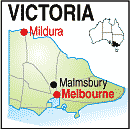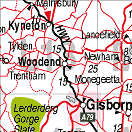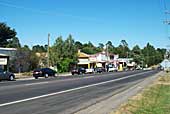|
Best known for its craft shops and bakery, this small town on the
Coliban River has many historical buildings in and around it,
some built with bluestone from the nearby quarry. Malmsbury was first settled in 1837 when Alexander Mollison camped by the Coliban River and was so impressed with the place he settled there and named it Malmsbury after James Howard Harris, the 3rd Earl of Malmsbury (1807-1889). It has a population of around 500 and is located 95km north west of Melbourne and 11km north of Kyneton on the Calder Hwy. The town has a railway station which is a located on the Melbourne to Bendigo Railway Line and is in the north western area of Macedon Ranges Shire Local government area. The original inhabitants of the local area were the Dja Dja Wurrung people. Mollison brought 49 workers, 2 overseers, 22 horses, 5,000 sheep, 640 head of cattle and 28 working bullocks to establish the township. More settlers arrived to establish properties and the government allocated land to squatters and the region was quickly established and noted for its rich alluvial soil and moderate climate. Gold was discovered near the Coliban River in 1858 and the town became a service centre for diggers travelling to goldfields of Bendigo and Castlemaine to the north. This region of Victoria produced massive amounts of gold during the 1850s and 60s with the world's largest nugget found nearby at Moliagul to the west. Hordes of people passed through Malmsbury and this required the upgrading of the rough track which was the road. Tolls were introduced to pay for construction and Malmsbury had three tollgates, requiring the traveller to pay at each one before proceeding. By the mid 1800s Malmsbury was a thriving town with 4 churches, 2 schools, 2 banks, 17 hotels, 3 mills, a hospital, 2 breweries, a racecourse, town hall and many shops and businesses servicing miners and the community. Abundant bluestone was mined near Malmsbury and many prominent buildings in Victoria were constructed using local stone. The quality of the stone was such that it was exported across the colonies. The railway viaduct across the river is classified 'A' by the National Trust. The foundation stone was laid in 1859 and upon completion it was the largest masonry bridge in Australia. It is estimated some 4,000 men were employed in the construction of the bridge. The railway was constructed with double tracks to accommodate plans for a railway connection with Sydney. It was built by private contractors and cost £50,000 per mile ($100,000). The rail was important to Malmsbury and provided a means of moving the bluestone and local produce out and bringing workers and new settlers in. by 1851 there were 150 men working in and around Malmsbury. Today the streetscape is much as it was back then although many of the buildings have been demolished to make way for newer ones. The Malmsbury Historical Society can be contacted on (03) 5423 9188 and has records and photographs of the early days. PLACES OF INTEREST: Located beside the Coliban River the Malmsbury Botanical Gardens have significant historic value. Established in 1865 on nine hectares of river flats it is one of the earliest regional gardens in Victoria, preceded only by Geelong and Portland. Various flora was supplied by Baron Ferdinand von Mueller, then director of Melbourne's Royal Botanic Gardens who's contribution to botany in Australia is under-rated. It was von Mueller who first suggested planting date palms near waterholes in outback Australia to provide sustenace for travellers. The gardens were originally developed with a hedge maze and landscaped islands established within a natural billabong linked by timber bridges. They contain one of only four specimens in the state of the hybrid strawberry tree and species include mature pines, oak, willow, cedar, elm and poplar trees. Several species of waterbirds will be seen and there are picnic areas. A walking track leads from the gardens to the railway viaduct (1859). The bridge is one of the largest 19th-century engineering structures in the state and has five arched spans of 18 metres each and is 152 metres long. On the south-western corner of Mollison St (Calder Hwy) and Ross St, is the former Wesleyan Chapel (1870s). St John's Church of England was founded in 1866. It is open for services on the first and third Sunday of the month at 11.00 a.m. Opposite is the town's small bluestone primary school, built in 1873-74. The old bluestone mill (1856-57) is three storeys high with an additional attic section. It is now a restaurant and gallery. Opposite is Birthday Villa (c.1880-86). The old railway station (1859-60) is located at the end of Orr St. Malmsbury Reservoir (1866-72) is a popular fishing and recreation area west of town on the Daylesford Road. Take the first left after you cross the railway line. It was built to supply Castlemaine and Bendigo with water. There is a picnic area within a grove of pine trees. You will need a fishing license available at the local General Store. To the east of town, off the Malmsbury to Metcalfe Rd are the Metcalfe Cascades on the Coliban River. 2km north of town along a walking track beside the Mill 'Race' on the Coliban River.
|

|
© Copyright Peter W. Wilkins | |




